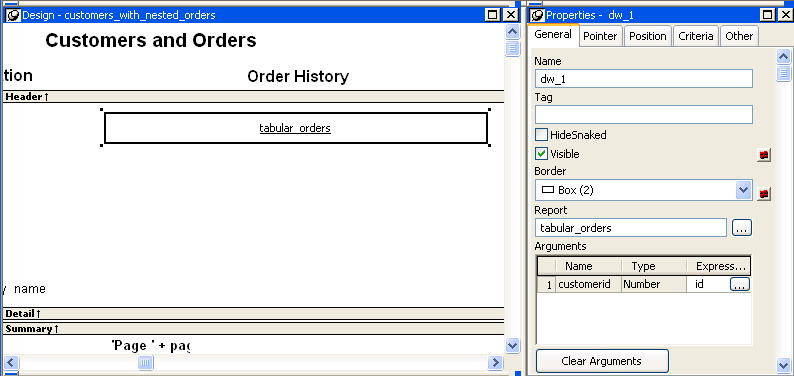Supplying retrieval arguments to relate a nested report to its
base report
The most efficient way to relate a nested report to its base
report is to use retrieval arguments. If your nested report has
arguments defined, you use the procedure described in this section to
supply the retrieval argument value from the base report to the nested
report. (The procedure described is part of the whole process covered
in Placing a related nested report in another
report.)
Why retrieval arguments are
efficient
Some DBMSs have the ability to bind input variables in the WHERE
clause of the SELECT statement. When you use retrieval arguments, a
DBMS with this capability sets up placeholders in the WHERE clause and
compiles the SELECT statement once. PowerBuilder retains this compiled
form of the SELECT statement for use in subsequent retrieval
requests.
Requirements for reusing the compiled
SELECT statement
To enable PowerBuilder to retain and reuse the compiled SELECT
statement:
-
The database interface must support binding of input
variables. -
You must enable binding support by setting the DisableBind
database parameter to 0, which is the default. -
You must enable caching in the database profile. Set the
SQLCache database parameter to the number of levels of nesting
plus 5.
For more information, see the description of the SQLCache and
DisableBind database parameters in the section called “SQLCache” in Connection Reference and the section called “DisableBind” in Connection Reference.
Nested reports in composite reports
If the base report is a composite report, you need to define
retrieval arguments for the composite report before you can supply
them to the nested report.
In the Properties view for the composite report, select the
General page. Then define the retrieval arguments that the nested
report needs, taking care to specify the correct type.
To supply a retrieval argument value from the base report to
the nested report
-
Make sure that the nested report has been set up to take one
or more retrieval arguments. -
Select the nested report and then select the General page of
the Properties view.The Arguments box lists arguments defined for the nested
report and provides a way for you to specify how information from
the base report will supply the value of the argument to the
nested report.
-
Supply the base report column or the expression that will
supply the argument’s value. To do this, click the button in the
Expression column.The Modify Expression dialog box displays. In this dialog
box, you can easily select one of the columns or develop an
expression. In the example, the column named id from the base
report will supply the value for the argument :customerid in the
nested report.When you run the report now, you are not prompted for
retrieval argument values for the nested report. The base report
supplies the retrieval argument values automatically.